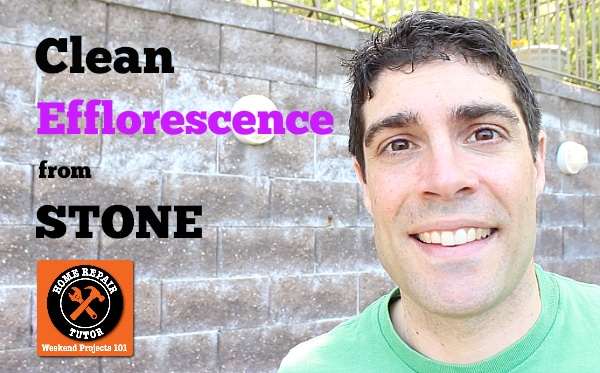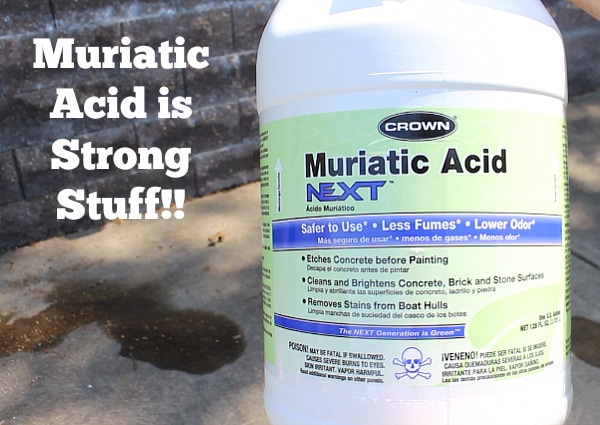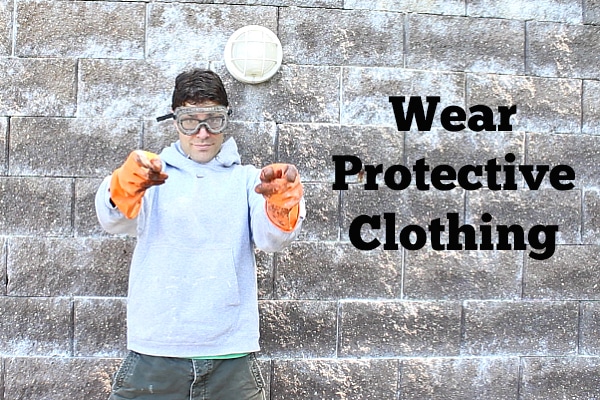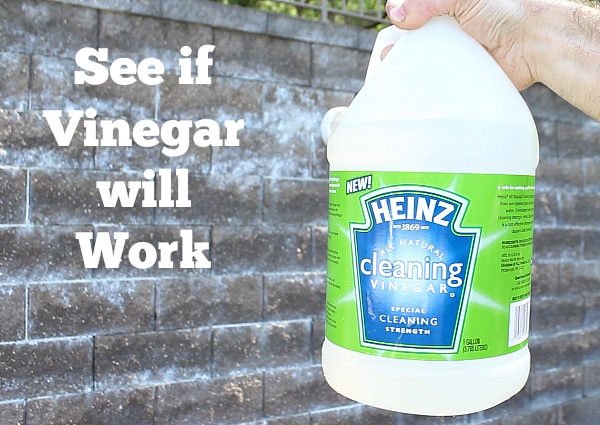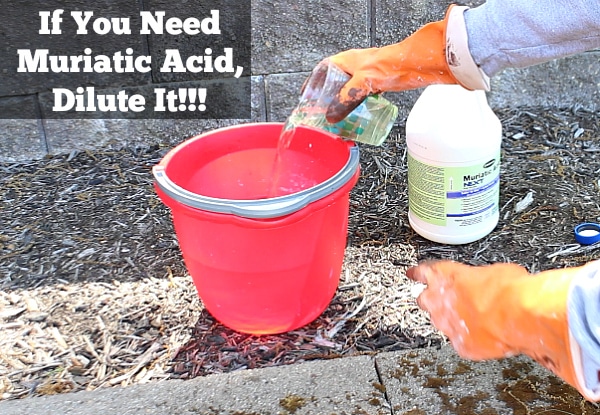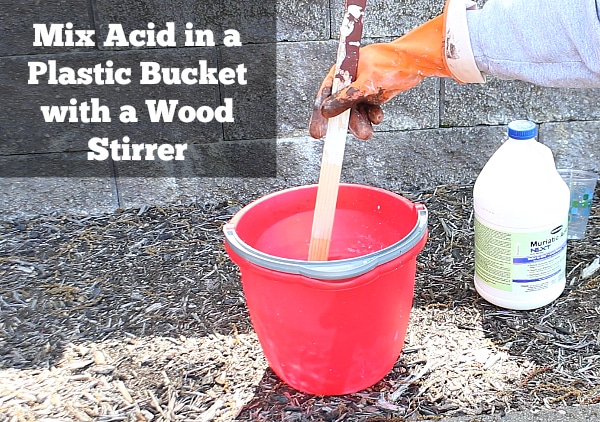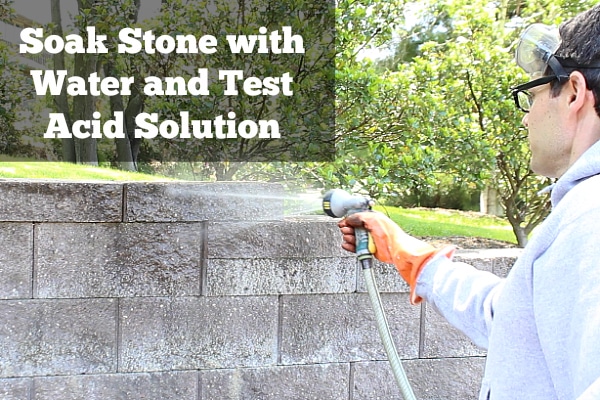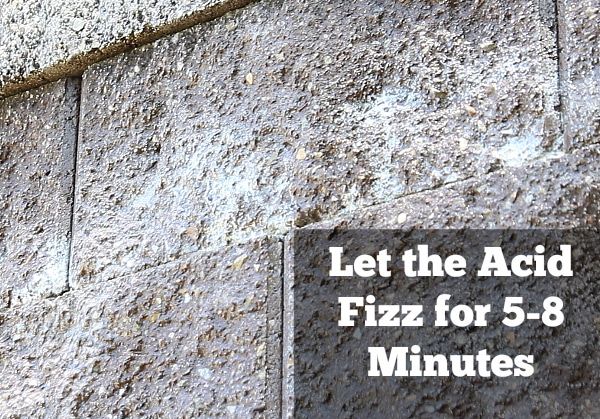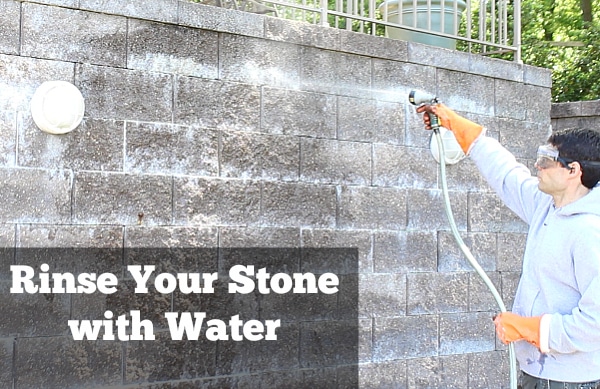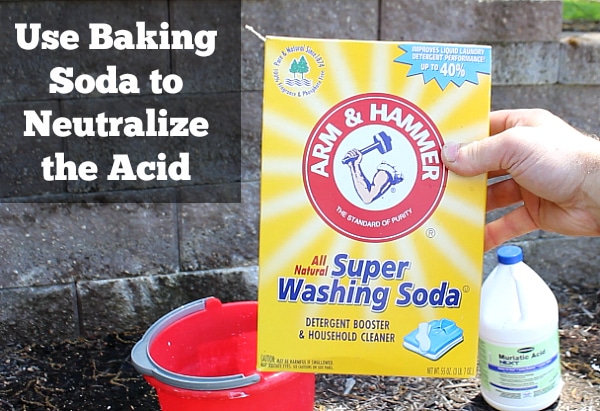Do your stone walls have efflorescence?
Mine do and it’s really REALLY bad.
Efflorescence leaves a white residue on stone and it’s just salt deposits from the soil or stone itself.
Let me tell you, it can be a big headache to remove.
Last weekend I tackled this project by using muriatic acid – which costs all of $7.29 and can be found at your local hardware store.
You’ll get your wall looking pretty darn good with this stuff but as you can imagine, there are a few tricks to using acids.
I’m excited to show you my before and after pics because they’re way cool.
Supplies for Cleaning Efflorescence
Muriatic acid is strong stuff.
You need to where goggles, chemical resistant gloves, a long shirt, pants, and shoes that don’t have mesh.
And whatever you do, don’t wear sandals!!!
Dilute the acid according to the bottle’s directions and this will lower the strength.
Here’s a HUGE IMPORTANT TIP: always add acid to water.
My 10th grade chemistry teacher, Mrs. Potter, would be proud to know that I still remember this and am passing it along (it’s also in the directions on the muriatic acid!!).
Thus, you’ll be adding water to a plastic bucket then adding the acid.
Here are all the supplies you need
- Muriatic Acid ($7.29)
- Chemical Resistant Gloves ($5)
- Goggles ($5)
- Baking Soda ($3)
- Plastic Bucket ($8)
- Plastic or Wood Stirrer (FREE)
- Plastic Brush ($4)
- Pole for Brush ($9)
- Hose (FREE)
- Long Sleeve Shirt, Pants, and Boots (FREE or borrow off a relative, haha)
- 1/2 Cup Measuring Cup (FREE)
- Plastic Cup for Measuring Acid (FREE)
Be Safe with This Stuff
As a kid I loved watching Mr. Rogers and learning about all sorts stuff.
Like how crayons are made or how Lou Ferrigno became the Incredible Hulk.
Great memories.
Mr. Rogers would likely want us all to stay safe.
So before getting started on this project I want you to put on your long sleeve shirt, pants, boots, goggles, and chemical resistant gloves.
That way you’ll be protected.
The next step is to test and see if you even need the muriatic acid.
Sometimes vinegar is all you need to clean off efflorescence. It’s undiluted acidity is about 6%, which is mild to say the least.
Wet down your wall with water. Before adding acid to it. This stops the acid from penetrating too deeply.
Add undiluted vinegar to a bucket and apply it to your stone with the plastic brush. See if it removes the white residue.
If it does then you don’t need to use muriatic acid.
If you need the muriatic acid you’ll have to dilute it according to the directions on the bottle.
I used Next muriatic acid and the recommended dilution was 1 part acid to 12 parts water.
Simply use a plastic cup (think party cup) to add the 12 cups of water to your plastic bucket. Then add the 1 cup of acid to your water.
Mix this solution using a wood paint stirrer.
Test the acid solution on a small section of your stone after soaking the wall with water. Apply it by using the plastic brush attached to a pole.
The acid will fizz when you add it to the efflorescence. This is normal.
Let the solution do its thing for 5 to 8 minutes then rinse it off with water. I used a garden hose.
Check that your stone isn’t chipping or falling apart.
I know this sounds scary but if you dilute the acid correctly it shouldn’t be an issue.
Once you’re sure the acid won’t ruin your stone you can move forward with the project.
Elbow Grease…Key Ingredient
What’s the trick to getting your stone wall looking like new after years of efflorescence?
Multiple applications of muriatic acid.
Before adding the acid to your stone you’ll want to soak the stone with water just like you did in the test run.
It’s so much better to apply a diluted solution of muriatic acid to your stone several times instead of one heaping dose.
When I say “application” I mean literally dipping your brush in the bucket and brushing the stone a few times and moving on to the next stone.
Nothing too crazy.
I let the acid do most of the work.
You’ll want to do the same thing. Otherwise it’ll be a very long day.
Let the acid work for 5-8 minutes then rinse it off with your garden hose.
The rinsing is important for two reasons:
- It helps remove the efflorescence from the stone
- It neutralizes the acid
As you’ll see in my video the results are pretty amazing. It took me about 15 applications to get the stones looking good. But each application was about 5 minutes of working time.
You can take one additional step to ensure the acid is fully neutralized.
And that is to add 1/2 cup of baking soda to one gallon of water. Mix the baking soda into the water and apply it to your stones.
This will totally neutralize the muriatic acid. Rinse the stone with water and you’re done.
What’s Next
Removing efflorescence from stone walls takes a bit of effort and this a good method for anyone with stubborn salt deposits.
Our tutorial on how to clean and prep a stone patio is also super helpful.
If you’re doing a bathroom remodel and need help, join one of our online courses – they’ll make your bathroom renovation much easier!
Let me know if you have any questions and I’ll do my best to help.
Thanks as always for reading, watching, and being part of our awesome community.
Cheers,
Jeff



